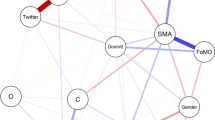Abstract
Using the normative data set of the Minnesota Multiphasic Personality Inventory-2 of the People’s Republic of China, this study examined the psychometric properties of the Personality Psychopathology Five facet subscales recently developed by Arnau et al. (2005). The internal consistency reliability, convergent and discriminant validity of the Psy-5 were found to be unsatisfactory. Results of confirmatory factor analysis (CFA) indicated that both item-to-facet factor structure (except the PSYC domain facets subscales) and facet-to-domain factor structure fit the data poorly. These findings suggested that the PSY-5 facet subscales may not be reliable and valid in population independent of those used to derive them. Thus, the utility of these facet subscales in clinical and research settings is premature at least for Chinese people at the present time.
Similar content being viewed by others
References
Arnau, R. C., Handel, R. W., & Archer, R. P. (2005). Principal components analyses of the MMPI-2 PSY-5 scales identification of facet subscales. Assessment, 12, 186–198.
Bagby, R. M., Costa, P. T., Widiger, T. A., Ryder, A. G., & Marshall, M. B. (2005). DSM-IV personality disorders and the five-factor model of personality: A multi-method examination of domain and facet level predictions. European Journal of Personality, 19, 1–18.
Bagby, R. M., Ryder, A. G., Ben-Dat, D., Bacchiochi, J., & Parker, J. D. A. (2002). Validation of the dimensional factor structure of the Personality Psychopathology Five in clinical and nonclinical samples. Journal of Personality Disorders, 16, 304–316.
Bagby, R. M., Sellbom, M., Costa, P. T., & Widiger, T. A. (2008). Predicting Diagnostic and Statistical Manual of Mental Disorders-IV personality disorders with the five-factor model of personality and the personality psychopathology five. Personality and Mental Health, 2, 55–69.
Butcher, J. N., Graham, J. R., Ben-Porath, Y. S., Tellegen, A., Dahlstrom, W. G., & Kaemmer, B. (2001). MMPI-2: Manual for the administration, scoring and interpretation. Minneapolis: University of Minnesota Press.
Byrne, B. M. (2001). Structural equation modeling with AMOS: Basic concepts, applications and programming. Mahwah, NJ: Erlbaum.
Cheung, F. M., Song, W. Z., & Zhang, J. X. (1991). The Chinese MMPI-2: Research and applications in Hong Kong and the People’s Republic of China. In J. N. Butcher (Ed.), International adaptations of the MMPI-2: Research and clinical applications (pp. 137–161). Minneapolis: The University of Minnesota Press.
Clark, L. A., & Watson, D. (1995). Constructing validity: Basic issues in scale development. Psychological Assessment, 7, 309–319.
Costa, P. T., & McCrae, R. R. (1992). Revised NEO Personality Inventory (NEO-PI-R) and NEO Five-Factor Inventory professional manual. Odessa, FL: Psychological Assessment Resources.
Fabrigar, L. R., Wegener, D. T., MacCallum, R. C., & Strahan, E. J. (1999). Evaluating the use of exploratory factor analysis in psychological research. Psychological Methods, 4, 272–299.
Harkness, A. R., McNulty, J. L., & Ben-Porath, Y. S. (1995). The Personality Psychopathology Five (PSY-5): Constructs and MMPI-2 scales. Psychological Assessment, 7, 104–114.
Harkness, A. R., McNulty, J. L., Ben-Porath, Y. S., & Graham, J. G. (2002). The Personality Psychopathology Five (PSY-5) scales. Minneapolis: University of Minnesota Press.
Kline, R. B. (2004). Principles and practice of structural equation modeling (2nd ed.). New York: Guilford Press.
Little, T. D., Lindenberger, U., & Nesselroade, J. R. (1999). On selecting indicators for multivariate measurement and modeling latent variables: When “good” indicators are bad and “bad” indicators are good. Psychological Methods, 4, 192–211.
MacCallum, R. C. (1986). Specification searches in covariance structure modeling. Psychological Bulletin, 100, 107–120.
McCrae, R. R., Zonderman, A. B., Costa, P. T., Jr., Bond, M. H., & Paunonen, S. V. (1996). Evaluating replicability of factors in the Revised NEO Personality Inventory: Confirmatory factor analysis versus Procrustes rotation. Journal of Personality and Social Psychology, 70, 552–566.
Miller, J. D., Lynam, D. R., Widiger, T. A., & Leukefeld, C. (2001). Personality disorders as extreme variants of common personality dimensions: Can the Five-Factor Model adequately represent psychopathy? Journal of Personality, 69, 253–276.
Muthén, L. K., & Muthén, B. O. (1998-2006). Mplus user’s guide (4th ed.). Los Angeles: Muthén & Muthén.
Netemeyer, R. G., Bearden, W. O., & Sharma, S. (2003). Scaling procedures: Issues and applications. Thousand Oaks, CA: Sage.
O’Connor, B. P. (2000). SPSS, SAS, and MATLAB programs for determining the number of components using parallel analysis and Velicer’s MAP test. Behavior Research Methods, Instruments, and Computers, 32, 396–402.
Petroskey, L. J., Ben-Porath, Y. S., & Stafford, K. P. (2003). Correlates of the Minnesota Multiphasic Personality Inventory–2 (MMPI-2) Personality Psychopathology Five (PSY-5) scales in a forensic assessment setting. Assessment, 10, 393–399.
Quilty, L. C., & Bagby, R. M. (2007). Psychometric and structural analysisof the MMPI-2 Personality Psychopathology Five (PSY-5) facet subscales. Assessment, 14, 375–384.
Wygant, D. B., Sellbom, M., Graham, J. R., & Schenk, P. W. (2006). Incremental validity of the MMPI-2 PSY-5 scales in assessing self-reported personality disorder criteria. Assessment, 13, 178–186.
Ullman, J. B. (1996). Structural equation modeling. In B. G. Tabachnick & L. S. Fidell (Eds.), Using multivariate statistics (pp. 708–819). New York: HarperCollins.
Author information
Authors and Affiliations
Corresponding author
Rights and permissions
About this article
Cite this article
Wang, L., Zhang, J., Shi, Z. et al. Internal Consistencies and Structural Analysis of the MMPI-2 PSY-5 Facet Subscales in Chinese Population. J Psychopathol Behav Assess 32, 150–155 (2010). https://doi.org/10.1007/s10862-009-9140-6
Published:
Issue Date:
DOI: https://doi.org/10.1007/s10862-009-9140-6




